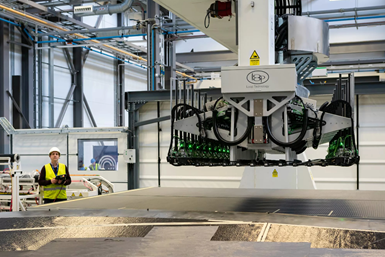Loop Technology automates complex prepreg layup through FibreFORM system
Suitable for prepreg and dry fiber materials, FibreFORM is capable of picking, placing and laying up composite plies with high accuracy and precision, with three times the speed of manual layup.
Loop Technology presents FibreFORM, a highly conformable system capable of picking composite plies from a flat surface and forming them onto a double curvature surface. Suitable for prepreg and dry fiber materials, FibreFORM can be used to manufacture a wide range of component types including aerospace part such as fuselage sections, wing skins, control surfaces, engine nacelles; blades for wind, tidal and engine applications; automotive panels; rail rolling stock; and radomes.
Deployed on a robot or gantry system, FibreFORM is able to carefully pick up composite plies using individually controlled suction cups (the model shown above has 270). Then, with its specially designed hand and wrist mechanisms, it reportedly manipulates the splines in such a way as to match the 3D surface of a tool, all with millimetric accuracy and precision. Loop Technology says the system can operate in fully horizontal and vertical planes or a combination of both. It can even operate in multiple orientations if the deployment system permits. Multiple modules can also be arranged in parallel, enabling the construction of systems capable of laying up wing skins up to 20+ meters long.
According to Loop Technology, the automated system performs 10x the deposition rate at three times the speed — up to 200 kg/hour — when compared to traditional handling methods. It also ensures positional repeatability of ±1 mm, though this is subject to material type and geometry.
Related Content
-
McLaren celebrates 10 years of the McLaren P1 hybrid hypercar
Lightweight carbon fiber construction, Formula 1-inspired aerodynamics and high-performance hybrid powertrain technologies hallmark this hybrid vehicle, serve as a springboard for new race cars.
-
The potential for thermoplastic composite nacelles
Collins Aerospace draws on global team, decades of experience to demonstrate large, curved AFP and welded structures for the next generation of aircraft.
-
PEEK vs. PEKK vs. PAEK and continuous compression molding
Suppliers of thermoplastics and carbon fiber chime in regarding PEEK vs. PEKK, and now PAEK, as well as in-situ consolidation — the supply chain for thermoplastic tape composites continues to evolve.













